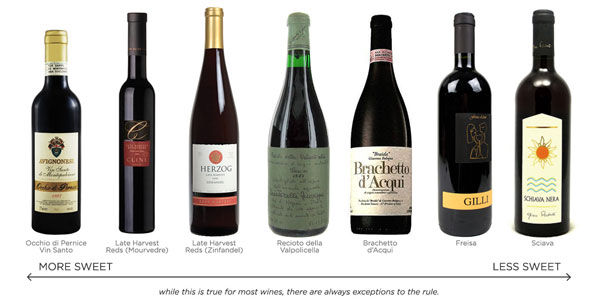
A Brief Explanation
For starters, dessert wines or sweet wines come from extra-sweet grapes. The fermentation process differs in that it is halted before the yeast converts all grape sugars into alcohol. Whether it is by cooling the wine or adding brandy, the fermentation process is stopped. The wine is therefore sweetened with with natural grape sugars.
Even though there are hundreds of different types of dessert wines in the market, it’s easy to differ into 5 main styles. As most dessert wine are sweet, it can be consumed with fruit, cheese, a creamy dessert or by themselves. Generally, red dessert wines are best at room temperature. White and brown dessert wines are good when chilled.
Sparkling Dessert Wine
Due to the carbonation and high acidity in sparking wine, these types of wines tend to have a less sweeter taste compares to other dessert wines. Not only that, certain grape varieties smell sweeter than others which prompts us to think that some taste sweeter than others. For instance, a Demi-Sec (aka “Semi Secco”) Moscato tastes sweeter than a Demi-Sec Champagne even though both may have the same amount of sugar.
When looking for sweet dessert wine Champagnes and other sparklers, keep your eyes peeled for these words on the label:
- Demi-Sec* (means “off-dry” in French)
- Amabile (“slightly sweet” in Italian)
- Semi Secco* (“off-dry” in Italian)
- Doux (“sweet” in French)
- Dolce / Dulce (“sweet” in Italian / Spanish)
- Moelleux (“sweet” for some French wines)
*not to be confused with “Sec” or “Secco” which is the term for dry in French and Italian.
Lightly-Sweet Dessert Wine
As the name implies, light sweet wines are refreshingly sweet, which are perfect for the warm afternoons. Other than that, these types of dessert wines go perfectly with spicy foods like Indian or Southeast Asian cuisine. We recommend that you drink lightly-sweet wines close to the vintage date as possible. Save for some examples like the German Riesling which ages quite well.
In regards to flavor, these wines have strong fruit flavors and are well suited for fruit-based and vanilla-driven desserts. As an example, Gewürztraminer is known for its lychee and rose petals aromas. A Gewürztraminer pairs excellently with fruit tarts.
Richly Sweet Dessert Wine
This type of dessert wine are made with the highest quality grapes in an unfortified style. Additionally, many of these wines can age above 50 years as its sweetness and acidity preserves the fresh flavor. Some of these wines are important in the course of history, such as the Hungarian Tokaji (‘toe-kye’) which was a favorite of the Tzars of Russia; South African Constantia which became the obsession of the Dutch and English; and French Sauternes beloved by Americans during the early 1800’s.
Sweet Red Wine
In general, sweet reds are on decline in popularity, except for cheap commercial production. Luckily there are still some well-made historically interesting sweet red wines worth trying. The majority of these sweet red wines worth trying are from Italy using esoteric grapes.
Fortified Wine
Finally, another type of wine which is also a dessert wine is the fortified wine. This type of wine is made with grape brandy added to the wine. Flavor-wise, it can either be dry or sweet. Most fortified wines are higher in alcohol content (about 17-20% ABV) and therefore have a longer shelf life after they are opened.





